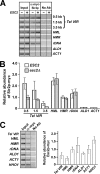Saccharomyces cerevisiae Esc2p interacts with Sir2p through a small ubiquitin-like modifier (SUMO)-binding motif and regulates transcriptionally silent chromatin in a locus-dependent manner
- PMID: 20048165
- PMCID: PMC2844200
- DOI: 10.1074/jbc.M109.016360
Saccharomyces cerevisiae Esc2p interacts with Sir2p through a small ubiquitin-like modifier (SUMO)-binding motif and regulates transcriptionally silent chromatin in a locus-dependent manner
Abstract
Saccharomyces cerevisiae Esc2p is a member of a conserved family of proteins that contain small ubiquitin-like modifier (SUMO)-like domains. It has been implicated in transcriptional silencing and shown to interact with the silencing protein Sir2p in a two-hybrid analysis. However, little is known about how Esc2p regulates the structure of silent chromatin. We demonstrate here that ESC2 differentially regulates silent chromatin at telomeric, rDNA, and HM loci. Specifically, ESC2 is required for efficient telomeric silencing and Sir2p association with telomeric silent chromatin and for silencing and maintenance of silent chromatin structure at rDNA. On the other hand, ESC2 negatively regulates silencing at HML and HMR and destabilizes HML silent chromatin without affecting Sir2p association with chromatin. We present evidence that Esc2p is associated with both transcriptionally silent and active loci in the genome, and the abundance of Esc2p is not correlated with the chromatin state at a particular locus. Using affinity pull-down analyses, we show that Esc2p and Sir2p interact in vivo, and recombinant Esc2p and Sir2p interact directly. Moreover, we dissect Esc2p and identify a putative SUMO-binding motif that is necessary and sufficient for interacting with Sir2p and SUMO and is required for the function of Esc2p in transcriptional silencing.
Figures








Similar articles
-
The implication of Sir2 in replicative aging and senescence in Saccharomyces cerevisiae.Aging (Albany NY). 2011 Mar;3(3):319-24. doi: 10.18632/aging.100299. Aging (Albany NY). 2011. PMID: 21415463 Free PMC article. Review.
-
Structural analyses of Sum1-1p-dependent transcriptionally silent chromatin in Saccharomyces cerevisiae.J Mol Biol. 2006 Mar 10;356(5):1082-92. doi: 10.1016/j.jmb.2005.11.089. Epub 2005 Dec 20. J Mol Biol. 2006. PMID: 16406069
-
Restoration of silencing in Saccharomyces cerevisiae by tethering of a novel Sir2-interacting protein, Esc8.Genetics. 2002 Oct;162(2):633-45. doi: 10.1093/genetics/162.2.633. Genetics. 2002. PMID: 12399377 Free PMC article.
-
Regulation of transcriptional silencing in yeast by growth temperature.J Mol Biol. 2004 Dec 3;344(4):893-905. doi: 10.1016/j.jmb.2004.10.002. J Mol Biol. 2004. PMID: 15544800
-
The Nuts and Bolts of Transcriptionally Silent Chromatin in Saccharomyces cerevisiae.Genetics. 2016 Aug;203(4):1563-99. doi: 10.1534/genetics.112.145243. Genetics. 2016. PMID: 27516616 Free PMC article. Review.
Cited by
-
The implication of Sir2 in replicative aging and senescence in Saccharomyces cerevisiae.Aging (Albany NY). 2011 Mar;3(3):319-24. doi: 10.18632/aging.100299. Aging (Albany NY). 2011. PMID: 21415463 Free PMC article. Review.
-
Heterochromatin formation via recruitment of DNA repair proteins.Mol Biol Cell. 2015 Apr 1;26(7):1395-410. doi: 10.1091/mbc.E14-09-1413. Epub 2015 Jan 28. Mol Biol Cell. 2015. PMID: 25631822 Free PMC article.
-
Esc2 promotes telomere stability in response to DNA replication stress.Nucleic Acids Res. 2019 May 21;47(9):4597-4611. doi: 10.1093/nar/gkz158. Nucleic Acids Res. 2019. PMID: 30838410 Free PMC article.
-
Linking replication stress with heterochromatin formation.Chromosoma. 2016 Jun;125(3):523-33. doi: 10.1007/s00412-015-0545-6. Epub 2015 Oct 28. Chromosoma. 2016. PMID: 26511280 Free PMC article. Review.
-
Role for rodent Smc6 in pericentromeric heterochromatin domains during spermatogonial differentiation and meiosis.Cell Death Dis. 2013 Aug 1;4(8):e749. doi: 10.1038/cddis.2013.269. Cell Death Dis. 2013. PMID: 23907463 Free PMC article.
References
-
- Rusche L. N., Kirchmaier A. L., Rine J. (2003) Annu. Rev. Biochem. 72, 481–516 - PubMed
-
- Braunstein M., Rose A. B., Holmes S. G., Allis C. D., Broach J. R. (1993) Genes Dev. 7, 592–604 - PubMed
-
- Moazed D. (2001) Curr. Opin. Cell Biol. 13, 232–238 - PubMed
-
- Suka N., Suka Y., Carmen A.A., Wu J., Grunstein M. (2001) Mol. Cell. 8, 473–479 - PubMed
-
- Shou W., Seol J. H., Shevchenko A., Baskerville C., Moazed D., Chen Z. W., Jang J., Shevchenko A., Charbonneau H., Deshaies R. J. (1999) Cell 97, 233–244 - PubMed
Publication types
MeSH terms
Substances
Grants and funding
LinkOut - more resources
Full Text Sources
Molecular Biology Databases

